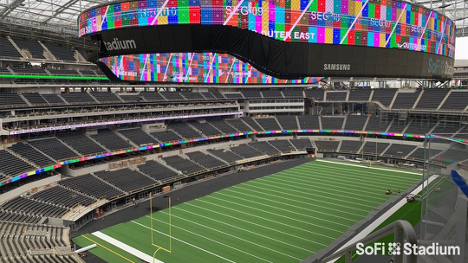Industry Insights: Response to COVID-19 Accelerates Adoption of AV Solutions for Sports Venues
 SoFi Stadium, the new home of the Los Angeles Rams and Los Angeles Chargers, features 113,800,000 total pixels across the 3 million sq. ft halo ring. Photo courtesy SoFi Stadium
SoFi Stadium, the new home of the Los Angeles Rams and Los Angeles Chargers, features 113,800,000 total pixels across the 3 million sq. ft halo ring. Photo courtesy SoFi Stadium
After five months of pandemic-induced change, it feels like we live in an entirely new world. But despite pundits professing a “new normal,” few trends being observed across the global economy are actually brand-new. They are merely perceived to be so with the hyper-acceleration of those trends emerging into the mainstream.
The sports and entertainment sector is no exception. A new venue costs billions of dollars to build and millions of dollars to operate each year. This pro forma was true in January and it’s even more true today with the additional overlay of COVID-19 protocols. The PwC Sports Outlook 2019 showed ticket sales and game attendance leveling off, even before the 2020 lockdowns. It’s been forced to zero now with the exception of the most loyal cardboard cutouts, who suffer extra innings and rain delays without even a bathroom break.
Rising expenses and eroding revenues is not a good business combination, which is why we are seeing more emphasis on creating new experiences and capturing new audiences. This trend, years in the making, is expected to endure and remain critical for years to come. The AVIXA® Industry Outlook and Trends Analysis (IOTA) reports that the Venues and Events category spends $28 billion on pro AV solutions. This is expected to rise at a compound annual growth rate of 6.6% over the next five years, leading to a full recovery from the pandemic spending decline in 2022 and climbing to a revenue total of $38.6 billion in 2025.
Design for Ultimate Flexibility
Sports venues have evolved into multipurpose event spaces, which is increasingly relevant to post-COVID-19 economics when limited crowd capacities will necessitate as many events as possible to help recoup lost revenue. In addition to main stick-and-ball tenants, numerous concerts, esports tournaments, corporate meetings, and cultural events are expected to be shoehorned into content calendars at venues staffed with fewer employees. To deliver on feverish fan expectations that vary by event type, venues will be required to flex, service, and scale through technology.
A flexible venue originates in part from its display network. Display technology allows delivery of custom experiences for each disparate event curated in the building, starting in the center of the building. Venue owners and operators still have a sweet tooth for massive center-hung video boards that push loads to their engineering limits, with each new build trumpeting their displays to be the biggest and baddest in the industry.
Size does matter, but flexibility matters more. In the new Chase Center in San Francisco, for example, a 9,699 sq. ft center-hung display, the largest in the NBA, can also be hidden by a gantry system under a false ceiling. This allows more rigging for performance artists, and concert attendees are none the wiser.
Deliver Immersive Experiences
Research suggests that 80 to 85% of our cognition is facilitated through our sense of sight. To capture fans with visual stimulation, venues have installed vast arrays of modular LED displays configured in imaginative shapes, that are HDR compatible for the most clear and crisp picture quality available. At SoFi Stadium, the new home of the Los Angeles Rams and Los Angeles Chargers, 113.8 million total pixels illuminate 3 million sq. ft, highlighted by a double-sided halo ring suspended over the field, measuring 1,051 feet long and 39 feet high.
But central displays with huge volumes of space to communicate team and sponsor messages to the masses are not enough. Concourse displays, from concession menu boards to wayfinding signage, also excite as well as inform. Interactive videowalls on down to smaller displays in private spaces, often catering to a discerning premium audience with business entertainment needs, must deliver a return on investment for those clients paying top dollar. And in this era of virus-related fears and social distancing mandates, more displays are required to account for increased team communications sent to fans in venues, while at times working in tandem with crowd intelligence solutions to promote safety and peace of mind.
Rich content is everywhere, from the highest trafficked levels to private luxury suites, and it kicks in before the games kick off. Many sports venues now anchor mixed-use entertainment districts, and bigger and brighter LED displays mounted on building exteriors promote the venue’s tenants and key sponsors to motivate prospective visitors to action.
Drive Increased Revenue
Any capital expenditure can’t just be cool. It should also aim to pursue new paths to revenue and/or cost containment through more efficient operations.
A robust display network allows for the quick transformation of a venue from one event to the next, while permitting native environments for each one. Displays now wrap unique surfaces such as cylindrical concrete columns, as observed at Detroit’s Ford Field and Atlanta’s Mercedes-Benz Stadium, broadcasting video, gamification, and additional interactive content connected to major sponsors. Center-hung boards now incorporate underbelly displays, as seen at the Chase Center and first made popular at Little Caesars Arena in Detroit, to serve the highest paying ticket holders sitting courtside who otherwise would not have views of valuable content. With video displays ubiquitous, sports marketers can deliver messages dynamically to the right person at the right time in the right place to trigger a desired outcome most effectively.
Programmatic advertising will soon spread to sports venues. Leveraging mobile technology and sensor beacons, marketers will be able to analyze the demographics of specific public assembly areas in real time. When demographic clusters change, so will the ad profile, maximizing return on that advertising investment and driving revenue that doesn’t go obsolete. For stadiums or arenas without adequate display coverage for COVID-19-related messaging to fans, this targeted advertising solution is a way to turn sunk cost into revenue generation.
It’s still anyone’s guess at this point when sports teams will once again compete in front of capacity crowds. But we know for certain that whenever that day comes, sports and entertainment venues will need to sell differently and operate more efficiently to maximize top and bottom lines. Many of these challenges already existed before coronavirus became an unwelcome addition to our lexicon. COVID-19 has forced venues to take action sooner than some planned. The time is ripe to respond and invest in an eventual return to live sports.
For more on this topic, watch the Association of Luxury Suite Directors’ recent webinar on Multi-Use + Flexibility in Today’s Venues. And click here to register for the ALSD's 2020 Virtual Show.




